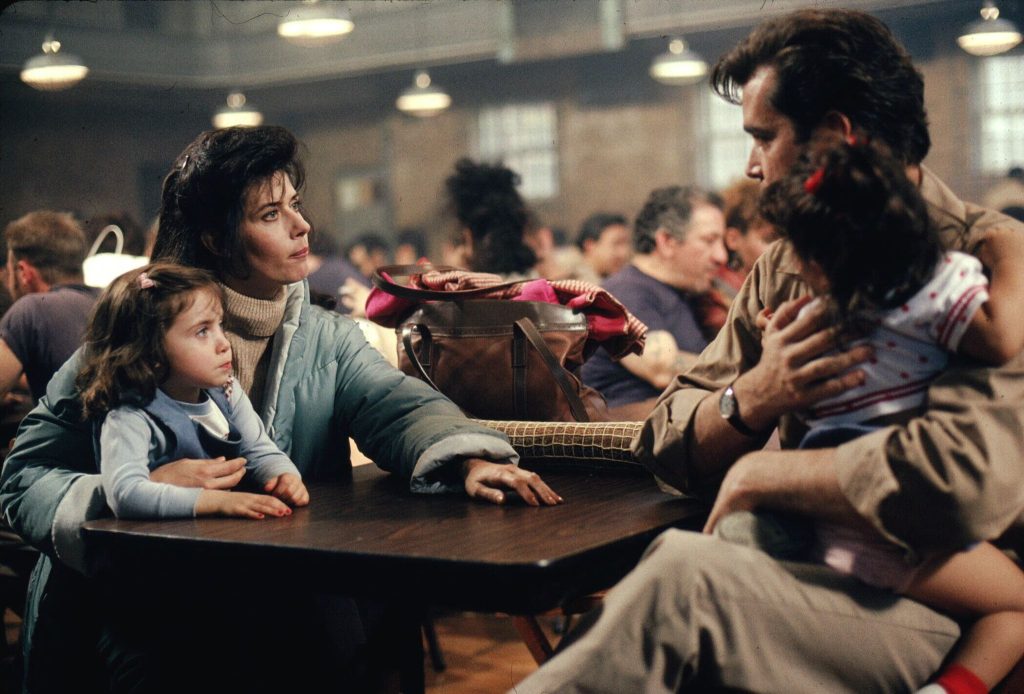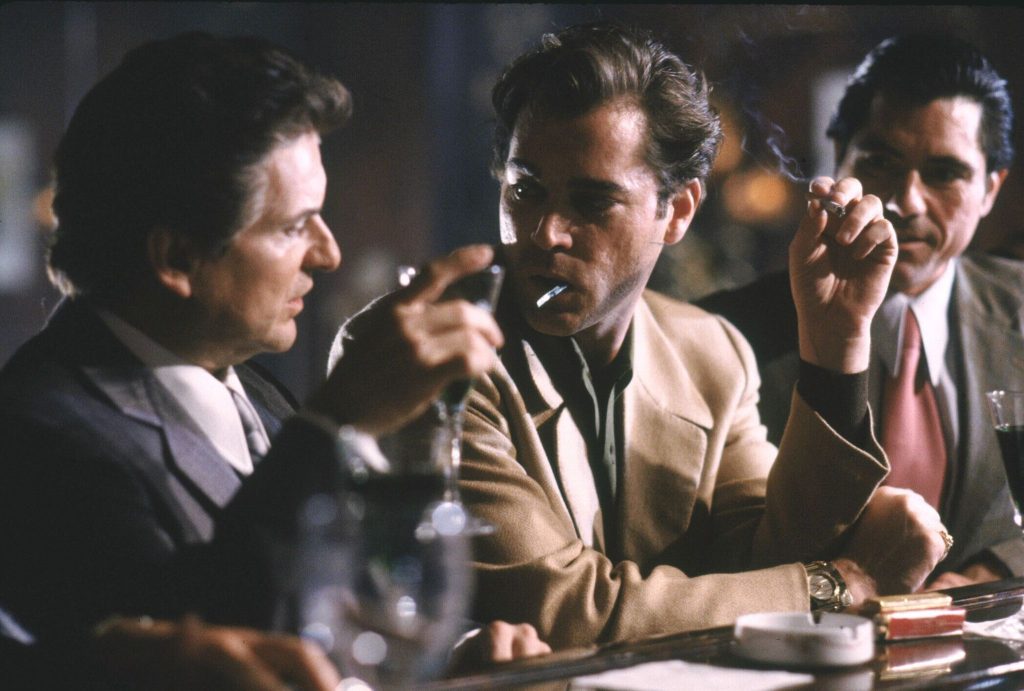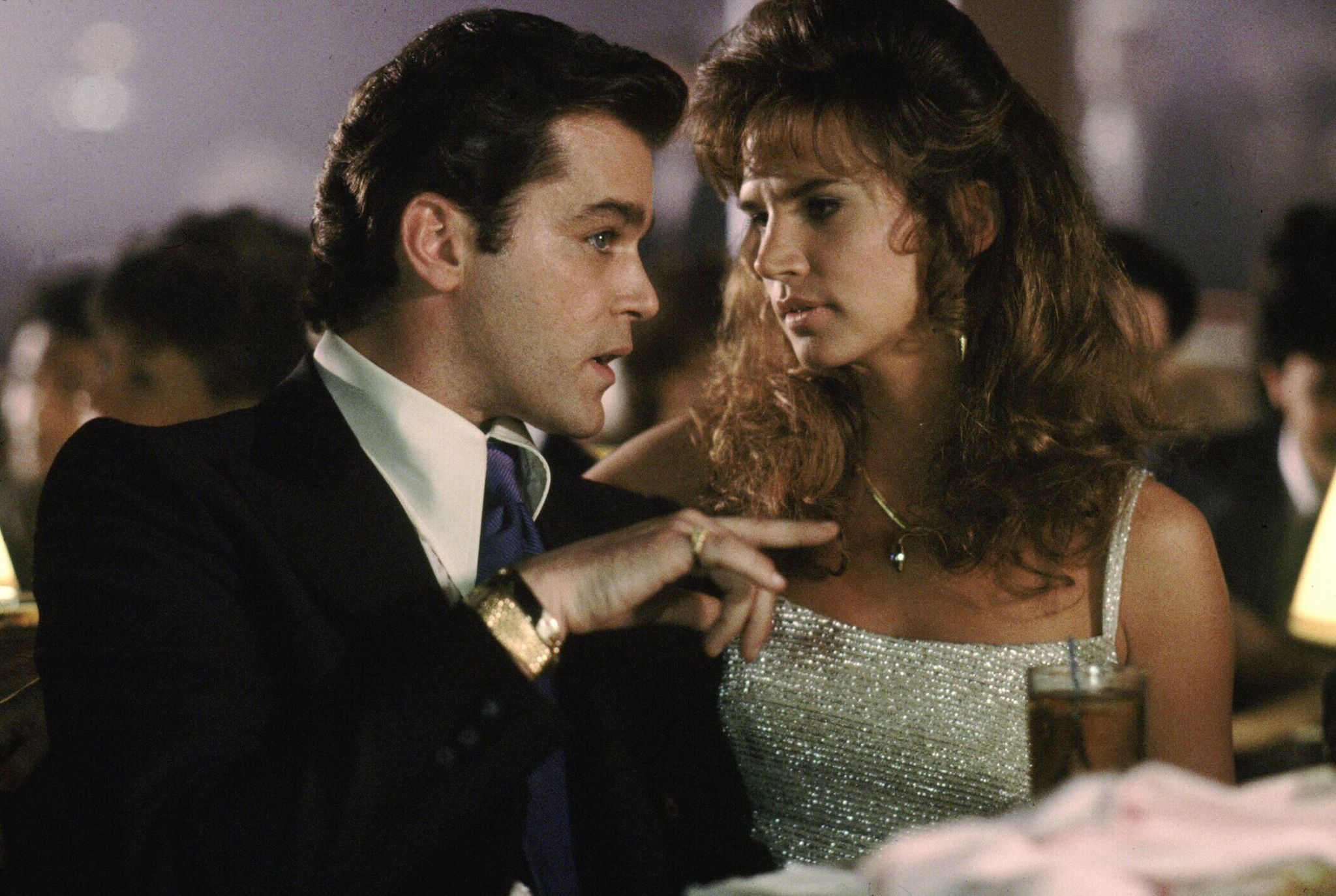“As far back as I can remember, I always wanted to be a gangster.” With these words, Martin Scorsese plunges us headlong into the intoxicating and ultimately tragic world of organized crime, not with Hollywood glamour, but with unstinting authenticity. “Goodfellas” doesn’t just depict the mafia life—it puts you in the passenger seat, making you complicit in its seductive appeal before showing you the horrific bill that comes due. Three decades later, this unflinching portrait of the mob’s golden era remains the definitive gangster film against which all others are measured.
Quick Summary Box
| Category | Details |
|---|---|
| Movie Name | Goodfellas (1990) |
| Director | Martin Scorsese |
| Cast | Ray Liotta, Robert De Niro, Joe Pesci, Lorraine Bracco |
| Genre | Crime, Biography, Drama |
| IMDb Rating | 8.7/10 ⭐ |
| Duration | 2h 26m |
| Where to Watch | HBO Max, Digital rental platforms |
| Release Date | September 19, 1990 |
Introduction: The Gangster Film Reimagined
When “Goodfellas” arrived in 1990, the gangster genre was largely defined by the operatic grandeur of “The Godfather” films—mythic tales of power, family, and the dark side of the American Dream. Martin Scorsese, drawing from Nicholas Pileggi’s non-fiction book “Wiseguy,” took a radically different approach. Rather than mythologizing organized crime, he demystified it, presenting the day-to-day reality of mob life through the eyes of Henry Hill (Ray Liotta), a half-Irish, half-Sicilian outsider who rose through the ranks before ultimately turning government informant.
With its kinetic camerawork, propulsive soundtrack featuring 43 popular songs, and narrative that spans three decades, “Goodfellas” reinvented the crime film with a documentary-like authenticity that never sacrifices cinematic bravura. Scorsese’s unflinching portrayal of criminals—not as tragic heroes or larger-than-life figures, but as dangerous, unpredictable sociopaths whose charm masks profound moral bankruptcy—set a new standard for realism in crime cinema that continues to influence filmmakers today.
Plot: Rise and Fall in the Criminal Underworld
The film follows Henry Hill from his teenage years in 1950s Brooklyn, where he’s drawn to the local gangsters who “owned the neighborhood” and treated with respect despite their criminal activities. Under the wing of Jimmy “The Gent” Conway (Robert De Niro) and Tommy DeVito (Joe Pesci), Henry learns the ins and outs of organized crime, from simple hijackings to elaborate heists. He embraces this lifestyle completely, marrying Jewish-American Karen (Lorraine Bracco), who is initially repulsed by but ultimately seduced by the wealth and excitement of mob life.
The narrative traces Henry’s ascent through the criminal hierarchy and the increasingly prosperous and violent 1960s and 70s. We witness pivotal events including the Lufthansa heist at JFK Airport—the largest cash robbery on American soil at that time—and the savage aftermath as Jimmy methodically eliminates anyone who might connect him to the crime.
As the 1980s arrive, Henry’s world begins to unravel. Cocaine becomes both a lucrative business opportunity and a destructive personal addiction. Paranoia sets in as the FBI closes in and his criminal associates—including the now-made man Tommy and the increasingly suspicious Jimmy—become potential threats rather than protectors. When Henry is finally arrested, he makes the life-altering decision to become a government witness, betraying the cardinal rule of mob life and entering witness protection with Karen and their children.
The film ends not with a dramatic death or triumphant escape, but with Henry lamenting the banality of his new existence: “I’m an average nobody. I get to live the rest of my life like a schnook.”
Performance Analysis: A Perfect Ensemble
“Goodfellas” features what may be the most perfectly cast ensemble in modern cinema, with each actor bringing precisely what their role demands:
Ray Liotta, in his breakthrough role, anchors the film with a performance of remarkable complexity. His Henry Hill is simultaneously charming and repellent, a man whose magnetic smile never quite reaches his watchful eyes. Liotta’s narration—sometimes exhilarated, sometimes frantic, eventually paranoid—guides us through this criminal world while his gradual transformation from ambitious young gangster to cocaine-addled paranoid captures the corrosive effects of the lifestyle he once coveted.
Robert De Niro, in his sixth collaboration with Scorsese, delivers a masterfully understated performance as Jimmy Conway. Unlike the volcanic Tommy or the narrating Henry, Jimmy’s menace lies in his calculation. De Niro communicates Jimmy’s deadly nature not through explosions of violence but through subtle shifts in his gaze or the sudden cooling of his demeanor. The scene where he invites newly made gangsters to celebrate, all the while planning their murders, showcases De Niro’s ability to layer warmth over ice-cold ruthlessness.
Joe Pesci creates in Tommy DeVito one of cinema’s most terrifying antagonists—a powder keg of rage contained in a diminutive frame. Pesci’s Oscar-winning performance balances Tommy’s humor (the famous “funny how?” scene) with hair-trigger violence, creating a character whose unpredictability generates almost unbearable tension whenever he’s on screen. Tommy embodies the film’s thesis about the gangster lifestyle: that beneath the camaraderie and humor lies psychopathic brutality.
Lorraine Bracco completes the core ensemble as Karen Hill, offering a crucial outsider-turned-insider perspective. Her character arc from repulsion to acceptance to complicity provides the film’s most compelling examination of moral corruption. Bracco’s voiceover narration, counterpointing Henry’s, gives “Goodfellas” a rounded perspective on mob life that previous gangster films often lacked.
The supporting cast, featuring actual ex-gangsters in minor roles, adds authenticity to even the smallest interactions, creating a lived-in world where every character, no matter how briefly seen, feels like they exist beyond the frame.
Visual Storytelling: Cinema in Perpetual Motion

Scorsese and cinematographer Michael Ballhaus created a visual approach as hyperactive and unpredictable as the characters themselves. The film’s bravura camera movements, particularly the legendary Copacabana tracking shot where Henry takes Karen through the club’s kitchen, serve multiple purposes: they demonstrate Henry’s insider status, seduce the viewer just as Karen is being seduced, and create a sense of exhilarating momentum.
The film’s editing, by longtime Scorsese collaborator Thelma Schoonmaker, establishes different rhythms for different eras of Henry’s life. The earlier sequences flow with the confidence of youth and success; the cocaine-fueled final day of Henry’s criminal career is a masterpiece of frantic, paranoid cutting that puts viewers inside his deteriorating mental state. This progression creates a formal reflection of the narrative arc—we feel Henry’s world spinning out of control because the filmmaking itself becomes increasingly destabilized.
Scorsese’s use of music transforms the film into a cultural time capsule while adding emotional texture to each scene. Rather than relying on a traditional score, he creates what amounts to a curated playlist of period-specific pop music, with songs often commenting ironically on the action. The use of the final movement of “Layla” during the discovery of multiple bodies following the Lufthansa heist creates a haunting counterpoint, the piano coda lending unexpected poignancy to scenes of brutal retribution.
Color plays a crucial role in the visual storytelling as well. The warm, golden tones of Henry’s early years give way to harsher lighting as the consequences of his choices begin to manifest. By the cocaine-addled final act, the visual palette becomes as jagged and discordant as Henry’s mental state, with harsh fluorescents and sickly colors dominating.
Thematic Richness: The American Dream’s Dark Reflection
While “Goodfellas” works brilliantly as pure entertainment, its lasting power derives from its thematic complexity:
The Corruption of Community: The film portrays the mafia not as a secret society but as a twisted version of community. Henry’s initial attraction isn’t just to wealth but to belonging—to a group where he matters and is protected. This perversion of normal human desire for connection makes the gangster lifestyle comprehensible while highlighting its moral bankruptcy.
The Illusion of Loyalty: Though the gangsters constantly talk about loyalty and family, the film systematically exposes these claims as hollow. From Henry’s betrayal of Paulie by dealing drugs to Jimmy’s elimination of his accomplices, to Henry ultimately turning informant, the film portrays loyalty as a convenient fiction that dissolves when self-interest dictates.
The Banality of Evil: Rather than presenting gangsters as exceptional figures, Scorsese shows them as disturbingly ordinary men whose casual attitude toward violence is their most chilling characteristic. Scenes of domestic normalcy juxtaposed with brutal violence (Tommy’s mother serving dinner after he’s put a man in the trunk) highlight the cognitive dissonance required to live such a life.
The Price of the American Dream: Like many of Scorsese’s films, “Goodfellas” explores the dark side of American ambition. Henry embraces crime as a shortcut to the wealth, respect, and freedom that seem otherwise unattainable for someone of his background. The film suggests that his choices, while extreme, reflect a distinctly American impatience with playing by the rules.
Addiction and Control: Whether to drugs, money, or power, addiction becomes a central motif in the film’s second half. The spiraling cocaine use parallels Henry’s loss of control over his carefully constructed life, suggesting that the seeds of his downfall were present in the very things that made his rise possible—risk-taking, hedonism, and prioritizing immediate gratification.
Cultural Impact: Redefining a Genre
“Goodfellas” fundamentally changed how crime stories are told on screen. Its influence can be seen in countless films and television shows, from “The Sopranos” (which featured many actors from “Goodfellas” and similar thematic concerns) to “Breaking Bad” (which borrowed its structure of seducing viewers into identification with criminals before showing the moral cost). Its techniques—the freeze frame, the direct address narration, the long tracking shots, the period-specific soundtrack—have become part of the cinematic language.
Beyond its technical innovations, the film altered public perception of organized crime. By stripping away romantic notions of honor among thieves and showing the psychological reality of criminal life—the paranoia, betrayal, and moral compromise—”Goodfellas” offered a more nuanced understanding of why people enter this world and what it ultimately costs them.
The film’s dialogue has permeated popular culture, with lines like “Never rat on your friends, and always keep your mouth shut,” “Funny how?” and “As far back as I can remember, I always wanted to be a gangster” becoming instantly recognizable cultural touchstones. Its set pieces—particularly the Copacabana tracking shot and the “last day as a wiseguy” sequence—are studied in film schools and have been homaged and parodied countless times.
The Film’s Legacy: Scorsese’s Definitive Statement

While “Goodfellas” didn’t win Best Picture (losing to “Dances with Wolves” in one of the Academy’s most criticized decisions), its reputation has only grown over time. It is now widely regarded as one of the greatest films ever made and Scorsese’s definitive statement on organized crime, a topic he has returned to throughout his career.
For Scorsese himself, the film represented a triumphant return to form after the controversial reception of “The Last Temptation of Christ” and commercial disappointment of “New York, New York.” Its success reestablished him as one of America’s preeminent filmmakers and paved the way for later masterworks like “Casino,” “The Departed,” and “The Irishman,” all of which exist in conversation with “Goodfellas” while exploring different aspects of criminal psychology and American culture.
For the gangster film genre, “Goodfellas” marked a turning point away from romanticism toward a more complex moral vision. While not entirely demythologizing the gangster (the film is too intoxicatingly entertaining for that), it presented a more honest examination of criminal psychology than previous entries in the genre, influencing everything from “Pulp Fiction” to “American Gangster.”
Most importantly, “Goodfellas” endures because it never sacrifices entertainment for its moral message or vice versa. It is simultaneously one of the most enjoyable films ever made—vibrant, funny, surprising—and one of the most disquieting in its portrayal of moral corruption. This combination of surface pleasure and moral depth ensures it remains as powerful today as upon its release.
Conclusion: The Definitive Gangster Film
“Goodfellas” stands as Martin Scorsese’s masterpiece—a perfect synthesis of his thematic concerns, technical virtuosity, and uncompromising vision. By showing us the world through Henry Hill’s eyes, allowing us to experience both the intoxication of his lifestyle and the devastation of its consequences, Scorsese created not just a great crime film but a profound meditation on American values, moral compromise, and the nature of community.
The film’s brilliance lies in its refusal to moralize explicitly while constructing a narrative that inevitably leads to moral conclusions. We are never told that crime doesn’t pay—we are shown, in excruciating detail, the psychological toll of living outside society’s boundaries. By making us complicit in Henry’s journey—laughing at Tommy’s jokes despite knowing his capacity for violence, admiring Jimmy’s professionalism despite understanding its lethal implications—Scorsese implicates viewers in the moral calculus of the characters, forcing us to examine our own fascination with transgression.
Three decades after its release, “Goodfellas” remains the definitive gangster film—not because it glorifies crime, but because it understands its appeal while unflinchingly portraying its consequences. In an era of increasingly complex antiheroes and morally ambiguous protagonists, “Goodfellas” reminds us that great cinema can seduce us into identification with characters whose choices we would condemn in real life, creating an uncomfortable but illuminating tension between narrative pleasure and moral judgment.
Did You Know?
- Joe Pesci’s famous “Funny how?” scene was based on a real interaction he had with a gangster while working at a restaurant as a young man
- The film features over 300 scenes with over 130 speaking parts
- Real-life gangsters reportedly praised the film for its accuracy, with one calling it “the closest thing to the life”
- Scorsese’s parents both appear in the film—his mother as Tommy’s mother and his father as the prisoner who puts too many onions in the sauce
- The “May 11, 1980” sequence showing Henry’s last day as a wiseguy took six weeks to plan and shoot
Where to Watch
Available on HBO Max for subscribers and for digital rental or purchase on major platforms including Amazon Prime, Apple TV, and Google Play.
If You Enjoyed “Goodfellas,” You Might Also Like:
- “Casino” (1995) – Scorsese’s spiritual sequel exploring organized crime in Las Vegas
- “The Departed” (2006) – Scorsese’s Oscar-winning crime thriller about identity and betrayal
- The Matrix (1999) – For its similarly revolutionary approach to filmmaking and genre reinvention
- Mickey 17 (2025) – For its exploration of identity and moral complexity in a completely different genre context

4 thoughts on “Goodfellas (1990) Review: Scorsese’s Visceral Masterpiece That Redefined Crime Cinema”